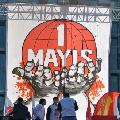
Turkish and Kurdish workers and youth send a signal of their strength
After 32 years of repression, on this year’s May Day, hundreds of thousands came together on Taksim Square in Istanbul, to participate in a lively and combative May Day demonstration.
Since 2009, the first of May has been a bank holiday in Turkey, but, until this year, to go to Taksim Square was not allowed. Last year, the police attacked workers, youth and left organisations who tried to enter the square.
In 1977, at the peak of a revolutionary movement in Turkey, half a million gathered there. Immediately after the demonstration began, snipers – from the fascist Grey Wolves, or from the police (this is still not clear today) – began shooting at the masses. More than 30 people were killed. The police again and again pushed people back onto the square as they tried to escape, which further increased the number of dead and injured. In 1980, the military organised a coup and brutally suppressed the workers’ movement. All future attempts to enter Taksim Square were blocked and people have again been killed trying to do so since 1977.

This year, the Turkish government promised a peaceful May Day and allowed the demonstration to take place on Taksim Square – after they had brutally attacked the protests of the Tekel workers on 1 April 2010. Given the re-strengthening of the workers’ movement, the government could not stop the masses.
Three demonstrations converged on Taksim Square. The biggest one was organised by the “revolutionary” trade union federation, DISK, and the left-wing public sector union, KESK. All the left groups also took part. The second one was organised by the Türk-Is federation, which is close to the state, and the third one by the conservative religious trade union federation, Hak-Is.
The left demonstration was a sea of red flags, songs, dancing, huge banners and loud, militant slogans.
It is difficult to say how many people took part as Taksim Square is so big. The governor of Istanbul spoke of about 150,000 attending the Kurdish paper, Gündem, gave the figure of 500,000 participants. However, more than 100,000 marched on the left demonstration alone. Hurriyet, a high profile daily Turkish paper, reported on over 200,000 people having attended the march.
The number of young demonstrators and the size of the Kurdish contingent, with more than 10,000 people, were both remarkable.
Tekel workers force Türk-Is leader to leave the stage

There was a strong showing of the tobacco workers: When Mustafa Kumlu, leader of the biggest trade union federation, Türk-Is, entered the stage, a delegation of these workers stormed it. The Tekel workers are organised in Tek-Gida Is, the food production union, which belongs to Türk-Is. But many workers felt betrayed by Kumlu and Türk Is, because of their role in the struggle which the Tekel workers have had to fight over the last month. Kumlu was booed and finally had to leave the stage!

In speeches afterwards, the role of the union bureaucracy was strongly criticised. But a real strategy; for example, for joint days of action and strike, to win the Tekel workers’ struggle, was not presented. This reflects a general weakness of the Turkish left.
Altogether, this was a very successful May Day: the first one since 1977 without attacks by the police. Hundreds of thousands of enthusiastic and militant people came together and celebrated the day of the workers’ movement: a strong sign of the re-awakening of the workers’ movement.
The re-building of the Turkish workers’ movement has entered an interesting and dynamic phase. The Turkish left is divided into a lot of (mostly stalinist) groups. But the Tekel strike has strengthened consciousness, politicising and activating a new layer of people. Thousands of new activists, mainly young people, have begun to participate in the re-building of the workers’ movement. How fast a socialist, left mass party of the Turkish working class can be built out of this process depends not least on the role of marxist forces, being able to build and offer an offensive strategy to bring together workers and youth to organise the fightback.
The re-entering of Taksim Square is an important symbol and encourages hundreds of thousands of workers and youth all over Turkey. With this encouragement, the struggle against the effects of the capitalist crisis could be massively strengthened. The resistance in Greece could have a big effect and show the way forward.

Be the first to comment